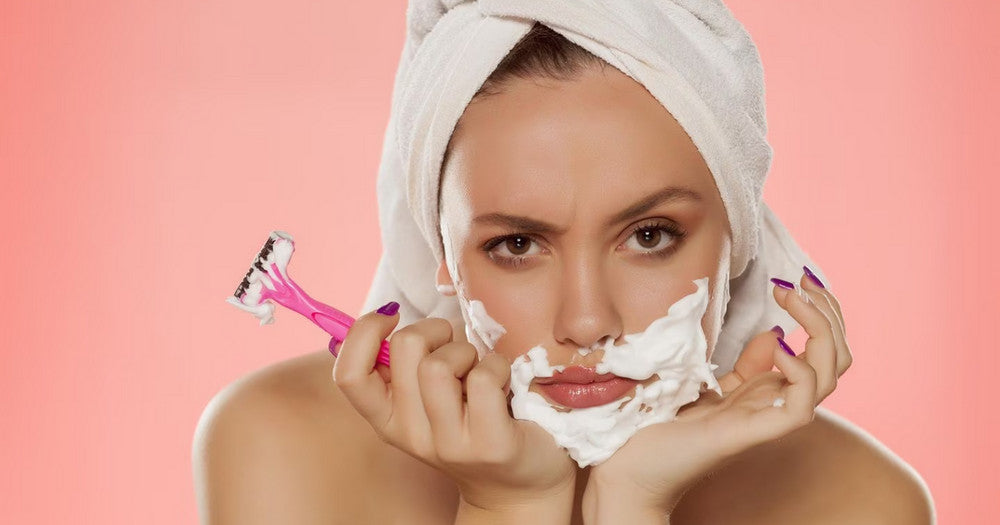Removing facial hair, especially shaving the beard, is an issue that concerns many women. Smooth skin is often portrayed as the ideal image of femininity, which leads to questions and insecurities regarding facial hair.
In this article, we'll explore various aspects of shaving your moustache . We'll discuss whether shaving is the right method, the importance of facial hair removal for women , and provide an overview of the various methods available. From the causes of hair growth to societal norms to the best techniques and product recommendations, this article is a comprehensive guide for any woman faced with the decision to shave or remove her moustache.
Shave your moustache, yes or no? We clear up misconceptions and explain how this personal decision can affect your self-esteem. Read on for sound information and expert advice so you can make the best decision for your skin and well-being.

- Part 1: Understanding Facial Hair in Women
- Part 2: Shaving your moustache: yes or no?
- Part 3: Shaving your beard: Disadvantages
- Part 4: Shaving your moustache: How often?
- Part 5: IPL: The best method according to experts
- Part 6: Other common methods for removing facial hair
- Part 7: Dealing with concerns and myths
- Part 8: Conclusion
Understanding facial hair in women
Facial hair in women, often referred to as a moustache, is a completely natural phenomenon. The reasons for its growth can be varied, ranging from genetic factors to hormonal influences. Hormonal changes, such as those that occur during puberty, pregnancy or menopause, can affect facial hair growth. Certain medical conditions and medications can also cause it.
Despite the naturalness of the phenomenon, there are many misconceptions and stigmas surrounding facial hair in women. It is often wrongly assumed that a beard is a sign of poor grooming or femininity, which can lead to unnecessary self-doubt and feelings of shame. It is important to dispel these misconceptions and understand that facial hair is a normal and natural part of the female body.
The decision whether and how to remove your facial hair is a highly personal one. It is not only about aesthetic preferences, but also about your own self-esteem and well-being. Every woman should feel free to accept or treat her facial hair as she sees fit, without pressure from societal norms or expectations. This choice is an expression of personal autonomy and respect for one's own body.
Shaving your moustache: yes or no?
The decision to shave a mustache depends on several factors. On the one hand, shaving offers a quick and easy way to remove hair, but it can also lead to skin irritation or faster hair regrowth. On the other hand, accepting and keeping a mustache can be a sign of self-acceptance and a break with traditional beauty norms.
In recent years, there has been a shift in the perception of body hair. There is a growing movement towards self-acceptance and breaking with outdated ideals of beauty. This change is also reflected in the decision whether or not to shave one's moustache. It is a highly personal decision that depends on individual preferences, comfort and one's lifestyle.
The decision to shave or not shave a moustache is also a reflection of social development. While removing facial hair was once taken for granted, there is now greater acceptance of different ways of dealing with body hair. This development promotes a healthier body image and self-esteem by reducing the pressure to conform to traditional beauty standards. The choice to shave or leave a moustache also becomes a form of personal expression and self-determination.
Shaving your beard: Disadvantages
Shaving your beard, a common practice, brings with it different experiences. It can lead to ingrown hairs that cause skin irritation or inflammation. There is also the risk of cuts, especially in cases of sensitive skin or improper use of shaving tools.
Another problem that can occur when shaving your beard is skin irritation. This can manifest itself in the form of redness, itching or burning, especially on sensitive skin. The use of certain shaving products or creams can also lead to allergic reactions or skin sensitivity.
Regular shaving or plucking of the beard can lead to a change in the hair structure. The hair can grow back stronger and more visibly, which can lead to a vicious cycle of more frequent shaving and stronger hair growth. In the long term, this can lead to the need to shave more frequently and more intensively in order to achieve the desired smoothness of the skin. It is therefore important to consider all aspects and, if necessary, explore alternatives to shaving in order to avoid long-term effects on the skin and hair growth.
Shaving your moustache : How often?
The need to shave a lady's beard depends largely on individual hair growth. Some women's hair grows faster and thicker, requiring more frequent shaving, while others' hair growth is slower and sparser. In addition to hair growth, personal preferences also play a role. Some prefer to shave daily for consistently smooth skin, while others are comfortable with less frequent shaves.

For those who choose to shave, the recommended interval varies. If you use a conventional razor, shaving every two to three days may be sufficient, but it is important to pay attention to how your skin reacts. If you notice any skin irritation or discomfort, it may be worth increasing the intervals between shaves.
When deciding how often to shave your beard, it's important to consider the health of your skin and the texture of your hair. Frequent shaving can be harsh on your skin, leading to dryness, redness, or ingrown hairs. A gentler approach or switching to other methods such as waxing or depilatory creams may be beneficial for sensitive skin. Additionally, regular shaving can change the texture of your hair, which should also be factored into the decision. It's important to find a balance that suits both your aesthetic desires and the health of your skin.
IPL: The best method according to experts
IPL hair removal is an efficient, long-lasting method known for its ease of use and safety for home use. It is less painful than waxing and more effective than shaving, but requires an initial investment and several treatments. Its effectiveness varies depending on hair and skin type.

Techniques and safety tips
When using an IPL device, it is important to follow the instructions carefully. This includes preparing the skin before treatment, such as shaving the affected areas to increase effectiveness. Safety is a key consideration, so the device should only be used on clean, unbroken skin.
It is advisable to carry out a skin tolerance test before the first use. Users should also adhere to the treatment intervals and moisturize the skin and protect it from sun exposure after the IPL treatment. Ulike devices often offer different intensity levels that can be adjusted to suit the individual skin type to ensure both safety and efficiency.
Other common methods for removing facial hair
Waxing
 Waxing is a popular method of hair removal that offers longer-lasting results than shaving. This method involves applying wax to the affected area and then quickly pulling it off, removing hair at the root. The advantages of waxing are the relatively slow time it takes for hair to grow back and a gradual reduction in hair density with regular use. However, waxing can be painful, especially in sensitive areas such as the face, and there is a risk of skin irritation and ingrown hairs.
Waxing is a popular method of hair removal that offers longer-lasting results than shaving. This method involves applying wax to the affected area and then quickly pulling it off, removing hair at the root. The advantages of waxing are the relatively slow time it takes for hair to grow back and a gradual reduction in hair density with regular use. However, waxing can be painful, especially in sensitive areas such as the face, and there is a risk of skin irritation and ingrown hairs.
Depilatory creams
Depilatory creams offer a pain-free alternative to waxing. They work by breaking down the proteins in the hair, making it easy to remove. This method is easy to use and can be done in the comfort of your own home, but it is important to do a patch test first to avoid allergic reactions. Depilatory creams can cause irritation on sensitive skin, and results often do not last as long as with other methods.
Laser hair removal
 Laser hair removal is an effective method for long-term results. A laser targets the hair follicles and destroys them, which permanently reduces hair growth. This method is particularly effective on dark hair and light skin, but may be less effective on other skin and hair types. Laser treatment requires multiple sessions and can be costly. Also, it is important to choose a qualified professional for the treatment to minimize risks and side effects.
Laser hair removal is an effective method for long-term results. A laser targets the hair follicles and destroys them, which permanently reduces hair growth. This method is particularly effective on dark hair and light skin, but may be less effective on other skin and hair types. Laser treatment requires multiple sessions and can be costly. Also, it is important to choose a qualified professional for the treatment to minimize risks and side effects.
electrolysis
Electrolysis is another permanent hair removal method that involves inserting a thin wire into the hair follicle and applying an electric current to stop hair growth. This method is time-consuming as each hair must be treated individually, but it offers permanent results. Electrolysis is suitable for all hair and skin types, but can cause pain and redness in sensitive skin.
Dealing with concerns and myths
There are many myths surrounding the removal of facial hair , such as that hair grows back thicker after shaving, which is not true. Each method has its advantages and disadvantages and works differently for each individual. The decision should be based on personal needs and skin type, taking into account factors such as frequency, possible skin reactions and long-term effects. If you are unsure, advice from professionals who can offer individual recommendations and care tips can help.
Conclusion
In our article, we looked at the removal of facial hair from various perspectives - from the causes to different removal methods and how to deal with myths. It is important to note that each method works differently for each individual and the decision should be based on your own needs.
We encourage you to make an informed decision that takes into account both your aesthetic desires and the health of your skin. If you are unsure, consulting a specialist may be advisable.
The decision whether and how to remove your beard is a personal one that reflects your self-image and well-being. It's about feeling comfortable in your own skin and making decisions that boost your self-confidence. True beauty comes from within and is reflected in your contentment and charisma.




























